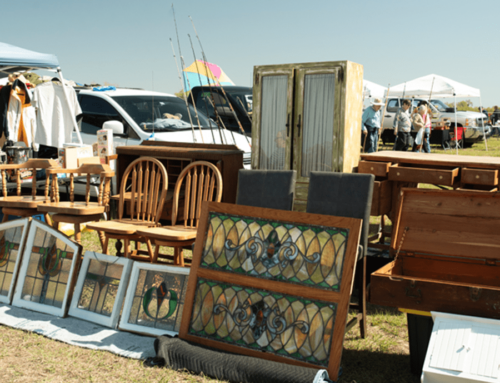By Mary Ann DeSantis
OUT+ABOUT: Family-Friendly Mardi Gras
PHOTOS: Mary Ann DeSantis and the Mobile Carnival Museum. Parade photo by Tad Denson of MyShotz.com
Most people assume Mardi Gras in the U.S. began in New Orleans, but history says otherwise. While the “Big Easy” may have the largest and most decadent celebrations, another Southern city gave birth to the traditional revelry that is a precursor to the Lenten season.
The children giggling and catching purple, green and gold beads thrown from carnival floats on Mobile, Alabama’s Royal Street are the first clue that this Mardi Gras is different. Mobile’s Fat Tuesday celebration is certainly family friendly, not the decadent, breast-baring frenzy that is synonymous with New Orleans carnival parades.
 And if you think the Mobile celebrations are tamed-down, knock-off versions of those to the west, just check the history books. French pioneers observed the first Mardi Gras in the New World at Fort Louis de la Mobile, a tiny settlement on a bluff near Mobile in 1703, more than 30 years before New Orleans held its first parade, which Mobile folks helped them organize. In 1704, Mobile established Masque de la Mobile, a secret society similar to current Mardi Gras krewes. In 1710, the Boeuf Gras Society was formed and paraded from 1711 through 1861, when “the war of Northern aggression” quieted the annual celebration just briefly.
And if you think the Mobile celebrations are tamed-down, knock-off versions of those to the west, just check the history books. French pioneers observed the first Mardi Gras in the New World at Fort Louis de la Mobile, a tiny settlement on a bluff near Mobile in 1703, more than 30 years before New Orleans held its first parade, which Mobile folks helped them organize. In 1704, Mobile established Masque de la Mobile, a secret society similar to current Mardi Gras krewes. In 1710, the Boeuf Gras Society was formed and paraded from 1711 through 1861, when “the war of Northern aggression” quieted the annual celebration just briefly.
“A lot of people not from this area do not realize Mobile’s role in the history of Mardi Gras,” says Judi Gulledge, Executive Director of the Mobile Carnival Museum. “The biggest difference today is we are family-focused with a lot of generational involvement.”
Nowhere is the history more apparent than the Mobile Carnival Museum, where 14 galleries are filled with Mardi Gras memorabilia, including elaborate bejeweled royal robes and gowns of queens and kings from 60-plus mystic societies.
 “Our most popular exhibits are the royal robes,” says Gulledge. “People just can’t imagine the magnitude the royal krewes go to celebrate their reigns, which is one night.”
“Our most popular exhibits are the royal robes,” says Gulledge. “People just can’t imagine the magnitude the royal krewes go to celebrate their reigns, which is one night.”
Housed in the historic Bernstein-Bush mansion on Government Street in downtown Mobile, the museum chronicles more than 300 years of Mobile’s Mardi Gras history. Colorful displays tell how the modern-day celebrations evolved from a papiér-maché ox, in honor of Boeuf Gras, being pulled down Dauphin Street. Today’s parades attract more than 850,000 people to Mobile just for Mardi Gras.
For me, the interactive exhibit of riding on a parade float was the biggest thrill and the closest I’ll come to being in a Mardi Gras parade. Surrounded by tableaux vivants (or living pictures) of crowds, I could almost hear the painted figures yelling for the highly collectible doubloons and beads.
The mansion’s small front entrance belies the massive warehouse and galleries inside, as well as the fun that surrounds Mardi Gras. For only a $5 admission fee, I spent a full morning touring a museum that is both entertaining and historical. The tour guide shared little-known facts, such as pig bladders were used for early balloons, and Moon Pies, the traditional marshmallow cookie, were first thrown by Mobile’s Mardi Gras revelers. All that trivia certainly created giggles and smiles among the youngest merrymakers.
HISTORY OF MARDI GRAS
Although the origins of Mardi Gras can be traced to medieval Europe, it was the French who brought the celebration as we know it to their New World colonies. Just as the medieval Christians prepared one last day of feasting before the penitential season of Lent began, early settlers used up their eggs, butter and milk — fatty ingredients forbidden during Lenten abstinence — to make pancakes and pastries. Thus, Fat Tuesday is often called Pancake Day or Shrove Tuesday, which comes from the word shrive, meaning confess.
Mardi Gras, which literally translates to Fat Tuesday from French, is celebrated around the world with countries adding their own special traditions. Students samba their way through the streets of Rio de Janeiro, which hosts what is reportedly the world’s largest carnival. In Germany, the Fastnacht celebrations mark the “eve of the fast,” and in Italy, Venetians don intricate Carnivale masks that have become popular souvenirs all yearlong. While many places in the U.S. celebrate Mardi Gras, including Leesburg and Universal Studios in Orlando, only a handful of places are known for authentic experiences on Fat Tuesday, which will be Feb. 17 this year. Not surprisingly, those areas were once under French rule: New Orleans, the Mississippi Gulf Coast, Mobile and Pensacola.
TRAVEL TIP:
If you plan to visit Mobile during the two weeks of carnival season in February, you’ll have the best view of parades from Royal Street in front of the Historic Battle House Hotel. In fact, the balcony of the hotel will be filled with revelers who’ll have a bird’s eye view of the parade route. Be sure to stop in at the popular Joe Cain Café, also on Royal Street, to learn more about the colorful character who revived Mardi Gras in 1866. Cain led the Lost Cause Minstrels in a procession through the city in defiance of occupying Union troops, and he’s revered to this day with the Sunday before Fat Tuesday known as Joe Cain Day.
One Comment
Leave A Comment
Mary Ann DeSantis is a fellow of the Symposium for Professional Wine Writers, Napa Valley, and recently received certification from the Wine & Spirits Educational Trust (WSET). An award-winning journalist, she has written for Lake & Sumter Style since 2006.






































Mardi Gras is the fantastic event where every body enjoys and feel free to share happiness.
Thank You for this wonderful post.